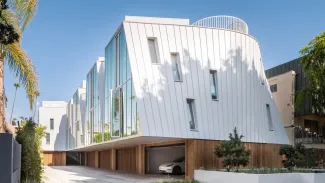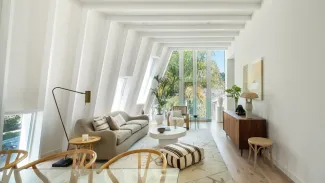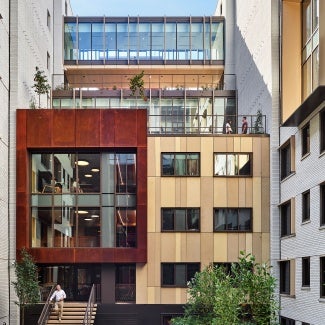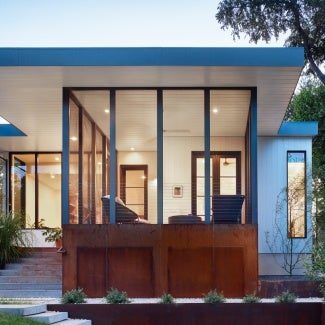Canyon Drive
The award-winning housing design of Canyon Drive in Los Angeles is an example of how to work within city ordinances to add density and create multifamily housing that still provides solar exposure and natural ventilation.

Project highlights: Canyon Drive
- Architect: Lorcan O'Herlihy Architects [LOHA]
- Owner: Leeor Maciborski;
- Location: Los Angeles
- Category: Multifamily Housing
- Project site: Previously developed
- Building program type(s): Residential — multifamily, 5 or more units
When it was adopted by Los Angeles in 2005, the city’s Small Lot Subdivision Ordinance was envisioned by smart growth proponents as a viable solution to the city’s extraordinarily tight housing market. Situated just south of LA’s Beachwood Canyon community, Canyon Drive is an exemplar of the new typology spurred by such ordinances whose homes are shaped by light and air.
Adding density by constructing faceless apartment complexes with little consideration for their context can sometimes alter a neighborhood’s character. This project boosts density while retaining the community’s values and identity.
Beginning with the maximum allowable envelope, Canyon Drive’s single mass is divided by a series of tilting exterior walls that define the five individual homes and offer opportunities for solar exposure and natural ventilation. Expanding from their initial A-frame shapes, the center of each homes’ volume maximizes square footage while maintaining the angular end facades. This tactic helps reinforce a sense of individuality missing in other small-lot subdivision developments.
Each of the homes’ ruled exterior facades, which appear somewhat nautical, were achieved through an innovative but simple framing strategy that relies on angle wall studs and strategic wood shear walls. Inside, the expressive wood framing ensures the overall geometry remains legible throughout the home. On the first floor, which contains two-car garages, cedar cladding contrasts with the aluminum panels and storefront glazing above. The team’s material choices help filter natural light into the living spaces while maintaining privacy, an essential strategy when building so close to other properties.
Increasing density in a car-centric city like Los Angeles raises concerns about adding even more cars to the street and a loss of parking. Each of Canyon Drive’s homes includes two standard parking spaces, consistent with single-family home requirements, though one is designated as a flexible guest space to minimize overflow parking in the neighborhood. For residents who are reconsidering their dependency on cars, the project is located within walking distance of two Metro stations.
The project represents the first step in a long process for the city as it considers densifying former single-family plots in other neighborhoods. As life during COVID-19 revealed, there remains a need for both personal space and community, and projects like Canyon Drive offer both.
Framework for Design Excellence measures
Was there a design charrette? Yes
Site area that supported vegetation (landscape or green roof) pre-development: 23%
Site area that supports vegetation post-development: 18%
Site area covered by native plants supporting native or migratory species and pollinators: 6%
Strategies used to promote Design for Ecosystems: Dark skies, Soil conservation, Habitat conservation, flora/fauna
Is potable water used for irrigation? Yes
Is potable water used for cooling? Yes
Is grey/blackwater reused on-site? No
Is rainwater collected on-site? Yes
Stormwater managed on-site: 85%
2030 Commitment baseline EUI: 39 kBtu/sf/yr
Predicted net EUI including on-site renewables: 39 kBtu/sf/yr
Reduction from the benchmark: Unknown
Is the project all-electric? No
Level of air filters installed: Less than MERV 9
Was a “chemicals of concern” list used to inform material selection? Yes
Do greater than 90% of occupied spaces have a direct view to the outdoors? Yes
Were embodied carbon emissions estimated for this project? No
Estimated service life: 40 years
Floor area, if any, representing adapting existing buildings: 0%
Ability to survive without utility power: Not habitable without power
Which of the following risk assessment and resilience services were provided? None of the above
Has a post-occupancy evaluation been conducted? No, but a POE will be conducted
Building performance transparency steps taken:
Present the design, outcomes, and/or lessons learned to the office
Present the design, outcomes, and/or lessons learned to the profession
Project team & jury
Year of substantial project completion: 2021
Gross conditioned floor area: 7401 sq. ft.
Principal-in-Charge: Lorcan O’Herlihy
Project Director: Brian Adolph, Nick Hopson
Project Lead: Dana Lydon, Santiago Tolosa
Project Team: Chris Gassaway, Ghazal Khezri, Christopher Lim
Catherine Baker, FAIA, Chair, Nowhere Collaborative, Chicago
John DeForest, AIA, DeForest Architects, Seattle
Brian Lane, FAIA, Koning Eizenberg, Santa Monica, Calif.
Amit Price Patel, AIA, DIALOG, Vancouver, British Columbia
Michael D. Robinson, AIA, Robi4 Architecture & Planning, San Diego
The Housing Award recognizes the best home design, presented by the AIA Housing and Community Development Knowledge Community.
Ten projects show the world how beauty, safety, sustainability, and comfort can come together.













